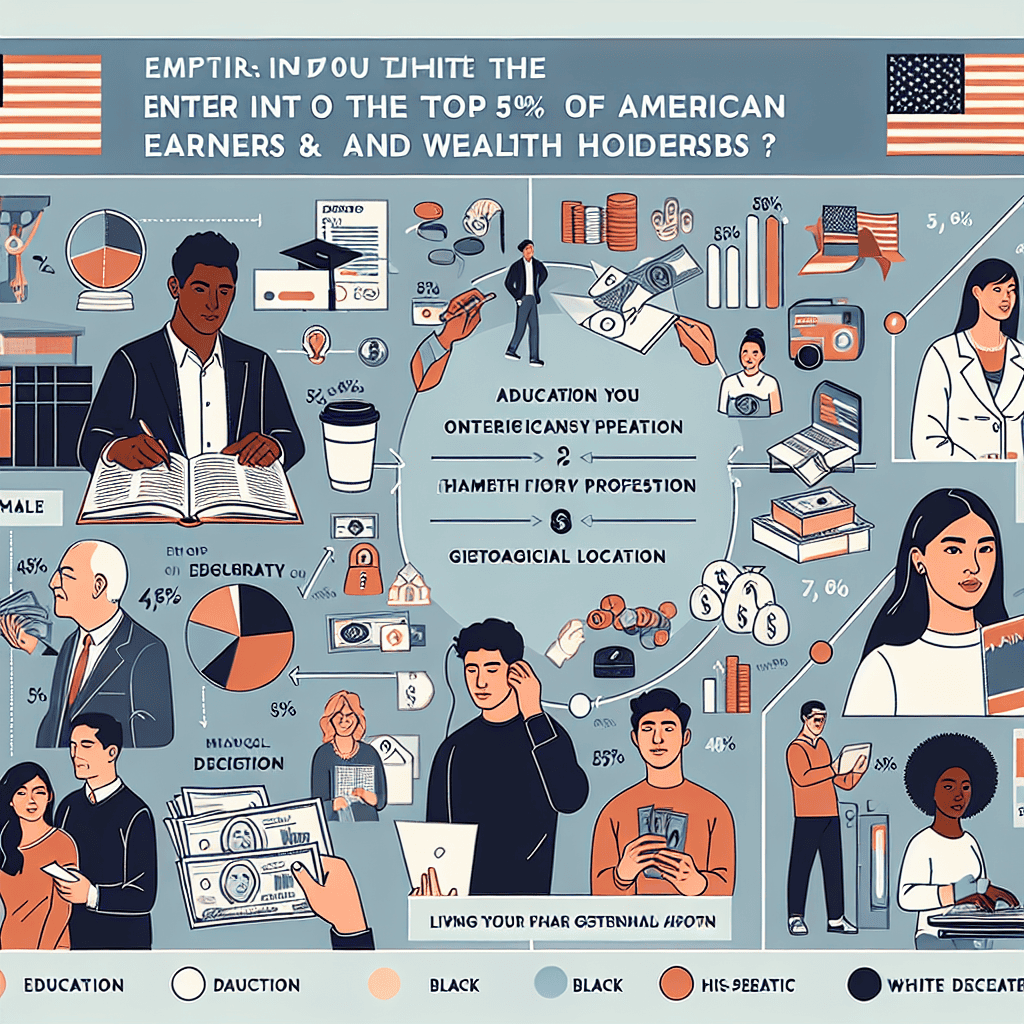“Unlocking Success: Strategies to Elevate Your Earnings and Wealth in America”
Introduction
Joining the top 50% of American earners and wealth holders requires a combination of strategic financial planning, education, and career advancement. It involves understanding the economic landscape, making informed decisions about investments, and often pursuing higher education or specialized skills to increase earning potential. Building wealth also necessitates disciplined saving, prudent spending, and effective debt management. Additionally, leveraging opportunities for career growth, such as networking and continuous learning, can significantly impact one’s financial trajectory. Ultimately, achieving this status is a multifaceted endeavor that combines personal initiative with an understanding of broader economic factors.
Understanding Income Distribution in America
Understanding income distribution in America requires a nuanced exploration of the factors that contribute to economic stratification. To join the top 50% of American earners and wealth holders, one must first comprehend the dynamics of income and wealth distribution, which are shaped by a myriad of elements including education, occupation, geographic location, and economic policies. The journey to the upper half of the economic spectrum is not merely about earning a higher salary; it involves a complex interplay of strategic financial decisions, investment in personal development, and an understanding of the broader economic landscape.
To begin with, education plays a pivotal role in determining one’s earning potential. Higher educational attainment often correlates with increased income, as it opens doors to more lucrative career opportunities. For instance, individuals with a bachelor’s degree or higher tend to earn significantly more than those with only a high school diploma. This educational advantage is further amplified by the choice of field, with degrees in science, technology, engineering, and mathematics (STEM) often leading to higher-paying jobs. Consequently, investing in education and skill development is a critical step for those aspiring to join the top 50% of earners.
Moreover, occupation and industry are crucial determinants of income. Certain professions, particularly those in technology, finance, and healthcare, offer higher salaries compared to others. Therefore, aligning one’s career path with industries that are experiencing growth and demand can significantly enhance earning potential. Additionally, gaining experience and expertise in a chosen field can lead to career advancement and salary increases, further propelling individuals toward the upper echelons of income distribution.
Geographic location also plays a significant role in income and wealth accumulation. The cost of living and average salaries vary widely across different regions in the United States. For example, urban areas such as San Francisco, New York, and Seattle tend to offer higher salaries but also come with a higher cost of living. Conversely, rural areas may offer lower salaries but also have a lower cost of living. Therefore, individuals must weigh these factors when considering relocation or job opportunities, as the net effect on disposable income can vary significantly.
In addition to earning a higher income, accumulating wealth is essential for joining the top 50% of wealth holders. This involves prudent financial management, including saving, investing, and minimizing debt. Building wealth requires a long-term perspective, with a focus on creating a diversified investment portfolio that can withstand market fluctuations. Real estate, stocks, bonds, and retirement accounts are common avenues for wealth accumulation, and understanding these investment vehicles is crucial for financial growth.
Furthermore, economic policies and tax structures can influence income distribution and wealth accumulation. Tax incentives for certain investments, changes in interest rates, and government programs can all impact an individual’s financial standing. Staying informed about these policies and adapting financial strategies accordingly can provide an advantage in the pursuit of economic advancement.
In conclusion, joining the top 50% of American earners and wealth holders is a multifaceted endeavor that requires strategic planning and informed decision-making. By investing in education, choosing the right career path, considering geographic implications, and managing finances wisely, individuals can enhance their economic prospects. Understanding the broader economic context and adapting to changes in policies and market conditions are also essential components of this journey. Through a combination of these efforts, individuals can navigate the complexities of income distribution and work towards achieving greater financial stability and success.
Key Skills and Education for Higher Earnings
Achieving a position among the top 50% of American earners and wealth holders is a goal that many aspire to, yet it requires a strategic approach encompassing both education and skill development. In today’s competitive economic landscape, the path to higher earnings is often paved with a combination of formal education, continuous learning, and the acquisition of key skills that are in demand across various industries. Understanding the interplay between these elements is crucial for anyone aiming to elevate their financial standing.
To begin with, education remains a fundamental pillar in the pursuit of higher earnings. A college degree, particularly in fields such as technology, engineering, finance, and healthcare, can significantly enhance one’s earning potential. These areas are not only lucrative but also offer a plethora of opportunities for career advancement. However, it is important to note that the value of education extends beyond the acquisition of a degree. The skills and knowledge gained during one’s academic journey lay the groundwork for future professional development and adaptability in a rapidly changing job market.
In addition to formal education, the cultivation of specific skills is essential for those seeking to join the ranks of higher earners. Technical skills, such as proficiency in data analysis, coding, and digital marketing, are increasingly sought after by employers. These skills enable individuals to contribute effectively to their organizations, thereby increasing their value and potential for higher compensation. Moreover, soft skills, including communication, problem-solving, and leadership, are equally important. These skills facilitate collaboration and innovation, which are critical in today’s interconnected and dynamic work environments.
Furthermore, the importance of lifelong learning cannot be overstated. As industries evolve and new technologies emerge, the ability to continuously update one’s skills is vital. This can be achieved through various means, such as online courses, workshops, and professional certifications. By staying abreast of industry trends and advancements, individuals can maintain their competitive edge and enhance their career prospects. This commitment to ongoing education not only boosts earning potential but also contributes to personal growth and job satisfaction.
Networking also plays a significant role in achieving higher earnings. Building a robust professional network can open doors to new opportunities and provide valuable insights into industry trends and best practices. Engaging with peers, mentors, and industry leaders can lead to collaborations and partnerships that may not only enhance one’s career but also lead to financial growth. Networking, therefore, should be viewed as an integral component of one’s professional development strategy.
In conclusion, joining the top 50% of American earners and wealth holders requires a multifaceted approach that combines education, skill development, lifelong learning, and networking. By investing in these areas, individuals can position themselves for success in a competitive job market. While the journey may be challenging, the rewards of financial stability and career fulfillment make it a worthwhile endeavor. As the economic landscape continues to evolve, those who are proactive in their pursuit of knowledge and skills will be best equipped to seize the opportunities that lie ahead.
The Role of Networking in Career Advancement
In the pursuit of joining the top 50% of American earners and wealth holders, one cannot overlook the pivotal role that networking plays in career advancement. Networking, often perceived as a mere social activity, is in fact a strategic tool that can significantly influence one’s professional trajectory. It serves as a bridge connecting individuals to opportunities that may otherwise remain inaccessible. As the job market becomes increasingly competitive, the ability to cultivate and leverage professional relationships has become more crucial than ever.
To begin with, networking facilitates access to information that is not readily available through conventional channels. Many job openings are not advertised publicly, and these hidden opportunities are often filled through referrals and recommendations. By building a robust network, individuals can tap into this hidden job market, gaining insights and leads that can propel their careers forward. Moreover, networking allows individuals to learn from the experiences of others, providing valuable guidance and mentorship that can help navigate the complexities of career advancement.
Furthermore, networking is instrumental in building a personal brand. In today’s digital age, where personal and professional lives are increasingly intertwined, establishing a strong personal brand is essential. Networking provides a platform to showcase one’s skills, achievements, and aspirations to a wider audience. By consistently engaging with industry peers and thought leaders, individuals can enhance their visibility and credibility, positioning themselves as experts in their field. This, in turn, can lead to new opportunities, such as speaking engagements, collaborations, and even job offers.
In addition to personal branding, networking also fosters the development of soft skills, which are highly valued in the workplace. Effective communication, active listening, and relationship-building are all integral components of successful networking. These skills not only enhance one’s ability to connect with others but also improve overall workplace performance. Employers often seek candidates who can work well in teams, adapt to changing environments, and build strong professional relationships. By honing these skills through networking, individuals can increase their employability and career prospects.
Moreover, networking can provide a sense of community and support, which is particularly important in times of career transition or uncertainty. Having a network of trusted colleagues and mentors can offer encouragement, advice, and resources when navigating challenges or exploring new opportunities. This support system can be invaluable in maintaining motivation and resilience, both of which are essential for long-term career success.
It is important to note that effective networking requires a strategic approach. It is not merely about collecting business cards or connecting on social media platforms. Rather, it involves building genuine relationships based on mutual respect and shared interests. This requires time, effort, and a willingness to give as much as one receives. By approaching networking with authenticity and a genuine interest in others, individuals can create meaningful connections that yield long-term benefits.
In conclusion, networking is a critical component of career advancement and plays a significant role in achieving financial success. By providing access to hidden opportunities, enhancing personal branding, developing soft skills, and offering community support, networking can help individuals join the top 50% of American earners and wealth holders. As the professional landscape continues to evolve, those who prioritize and invest in their networks will be better positioned to seize opportunities and achieve their career goals.
Smart Investment Strategies for Wealth Accumulation

Achieving a position among the top 50% of American earners and wealth holders is a goal that many aspire to, yet it requires a strategic approach to financial management and investment. To begin with, understanding the landscape of wealth accumulation is crucial. The journey to financial prosperity often starts with a disciplined approach to saving and investing. By consistently setting aside a portion of income, individuals can build a foundation for future investments. This disciplined saving habit is the cornerstone of wealth accumulation, as it provides the necessary capital to take advantage of investment opportunities.
Transitioning from saving to investing, it is essential to diversify one’s investment portfolio. Diversification is a strategy that involves spreading investments across various asset classes, such as stocks, bonds, real estate, and mutual funds. This approach minimizes risk by ensuring that the performance of one asset does not disproportionately affect the overall portfolio. For instance, while stocks may offer high returns, they also come with higher volatility. Balancing them with more stable investments like bonds can provide a buffer against market fluctuations.
Moreover, understanding the power of compound interest is vital for wealth accumulation. Compound interest allows investments to grow exponentially over time, as the returns earned on an investment are reinvested to generate additional earnings. This principle underscores the importance of starting to invest early. The longer the investment horizon, the more significant the impact of compounding, which can substantially increase wealth over time.
In addition to diversification and compounding, staying informed about market trends and economic indicators is crucial. Knowledge of market dynamics enables investors to make informed decisions and adjust their strategies accordingly. For example, during periods of economic growth, equities might perform well, whereas bonds could be more attractive during economic downturns. By staying informed, investors can capitalize on opportunities and mitigate potential risks.
Furthermore, tax-efficient investing is another critical component of smart investment strategies. Utilizing tax-advantaged accounts, such as 401(k)s and IRAs, can significantly enhance wealth accumulation by reducing taxable income and allowing investments to grow tax-deferred. Additionally, understanding the implications of capital gains taxes and strategically timing the sale of assets can further optimize tax efficiency.
While these strategies are fundamental, it is equally important to have a long-term perspective. Wealth accumulation is not a sprint but a marathon. Patience and perseverance are essential, as market volatility and economic uncertainties are inevitable. By maintaining a long-term focus, investors can avoid the pitfalls of emotional decision-making and stay committed to their financial goals.
Finally, seeking professional financial advice can be invaluable. Financial advisors can provide personalized guidance tailored to individual circumstances, helping to navigate complex investment landscapes and optimize strategies for wealth accumulation. They can also offer insights into emerging investment opportunities and help manage risks effectively.
In conclusion, joining the top 50% of American earners and wealth holders requires a multifaceted approach to investment. By adopting disciplined saving habits, diversifying investments, leveraging compound interest, staying informed, optimizing tax efficiency, maintaining a long-term perspective, and seeking professional advice, individuals can enhance their financial standing and work towards achieving their wealth accumulation goals. Through these smart investment strategies, the path to financial prosperity becomes more attainable.
The Impact of Financial Literacy on Wealth Building
Financial literacy plays a pivotal role in determining one’s ability to join the top 50% of American earners and wealth holders. As the economic landscape becomes increasingly complex, understanding financial principles is no longer a luxury but a necessity. The journey to financial success begins with a solid foundation of knowledge, which empowers individuals to make informed decisions about their money. This knowledge encompasses a wide range of topics, including budgeting, saving, investing, and understanding credit. By mastering these areas, individuals can effectively manage their finances, avoid common pitfalls, and ultimately build wealth over time.
One of the fundamental aspects of financial literacy is budgeting. A well-structured budget allows individuals to track their income and expenses, ensuring that they live within their means. This practice not only helps in avoiding debt but also enables the allocation of funds towards savings and investments. By prioritizing savings, individuals can create an emergency fund, which serves as a financial safety net during unforeseen circumstances. This financial cushion is crucial in preventing the derailment of long-term financial goals due to unexpected expenses.
In addition to budgeting, understanding the principles of saving and investing is essential for wealth accumulation. Saving is the act of setting aside money for future use, while investing involves putting money into assets with the expectation of generating a return. Both practices are integral to building wealth, but they require different strategies and levels of risk tolerance. Financially literate individuals recognize the importance of starting early, as the power of compound interest can significantly enhance the growth of their investments over time. By diversifying their investment portfolios, they can mitigate risks and increase the potential for higher returns.
Moreover, a comprehensive understanding of credit is vital for financial success. Credit scores play a significant role in determining an individual’s ability to secure loans, mortgages, and even employment opportunities. A high credit score can lead to lower interest rates and better loan terms, which can save individuals thousands of dollars over their lifetime. Financial literacy equips individuals with the knowledge to maintain a healthy credit score by managing debt responsibly, making timely payments, and keeping credit utilization low.
Furthermore, financial literacy extends beyond personal finance management to include an awareness of economic trends and policies that may impact one’s financial situation. By staying informed about changes in the economy, such as interest rate fluctuations or tax reforms, individuals can make proactive adjustments to their financial strategies. This adaptability is crucial in navigating the ever-changing financial landscape and seizing opportunities for wealth creation.
In conclusion, financial literacy is a key determinant in joining the top 50% of American earners and wealth holders. It empowers individuals to make informed decisions, manage their finances effectively, and build wealth over time. By mastering the principles of budgeting, saving, investing, and understanding credit, individuals can lay a strong foundation for financial success. Additionally, staying informed about economic trends allows for adaptability and strategic planning. As financial literacy becomes increasingly important in today’s complex economy, investing in education and resources to enhance one’s financial knowledge is a prudent step towards achieving long-term financial goals.
Balancing Risk and Reward in Career Choices
In the pursuit of joining the top 50% of American earners and wealth holders, individuals often find themselves at a crossroads where they must balance risk and reward in their career choices. This delicate equilibrium is crucial, as it can significantly influence one’s financial trajectory and overall economic well-being. To navigate this complex landscape, it is essential to understand the factors that contribute to financial success and how strategic career decisions can propel individuals toward their goals.
Firstly, education plays a pivotal role in shaping career opportunities and potential earnings. Higher educational attainment often correlates with increased earning potential, as it opens doors to specialized fields and positions that offer competitive salaries. However, the decision to pursue further education must be weighed against the potential debt incurred and the time investment required. For instance, while a degree in medicine or law can lead to lucrative careers, the associated costs and years of study necessitate careful consideration of the long-term benefits versus the immediate financial burden.
Moreover, the choice of industry significantly impacts earning potential. Sectors such as technology, finance, and healthcare are known for offering higher salaries and robust growth prospects. These industries often demand a specific skill set and adaptability to evolving trends, which can present both opportunities and challenges. For example, the tech industry is characterized by rapid innovation, requiring professionals to continuously update their skills to remain competitive. This dynamic environment can be rewarding for those who thrive on change and are willing to take calculated risks to advance their careers.
In addition to industry selection, the willingness to relocate can also influence career advancement and earning potential. Certain regions in the United States, such as Silicon Valley or New York City, are hubs for high-paying jobs and offer a plethora of opportunities for career growth. However, relocating to these areas often comes with a higher cost of living, which must be factored into the decision-making process. Balancing the potential for increased earnings with the expenses associated with living in a major metropolitan area is a critical consideration for those aiming to enhance their financial standing.
Furthermore, entrepreneurship presents another avenue for achieving financial success, albeit with a higher degree of risk. Starting a business can lead to substantial rewards, but it requires a significant investment of time, resources, and effort. Entrepreneurs must possess a strong understanding of market dynamics, consumer needs, and financial management to succeed. While the path of entrepreneurship is fraught with uncertainties, it offers the potential for significant financial gains and the satisfaction of building something from the ground up.
Lastly, networking and continuous professional development are essential components of career advancement. Building a robust professional network can lead to new opportunities, mentorship, and collaborations that enhance one’s career prospects. Additionally, investing in skill development through workshops, certifications, and training programs can increase employability and open doors to higher-paying positions.
In conclusion, joining the top 50% of American earners and wealth holders requires a strategic approach to career choices, where individuals must carefully balance risk and reward. By considering factors such as education, industry selection, geographic mobility, entrepreneurship, and professional development, individuals can make informed decisions that align with their financial goals and aspirations. Ultimately, the path to financial success is a multifaceted journey that demands foresight, adaptability, and a willingness to embrace calculated risks.
The Importance of Continuous Learning and Adaptation
In today’s rapidly evolving economic landscape, joining the top 50% of American earners and wealth holders requires more than just a traditional education and a steady job. It demands a commitment to continuous learning and adaptation, as the skills and knowledge that were once sufficient for financial success are now constantly shifting. The importance of lifelong learning cannot be overstated, as it equips individuals with the tools necessary to navigate the complexities of the modern economy and seize opportunities for advancement.
To begin with, the pace of technological advancement has fundamentally altered the job market, rendering certain skills obsolete while creating demand for new ones. As automation and artificial intelligence continue to reshape industries, workers must be proactive in updating their skill sets to remain competitive. This involves not only acquiring technical skills but also developing soft skills such as critical thinking, problem-solving, and emotional intelligence. By embracing a mindset of continuous learning, individuals can better position themselves to adapt to these changes and secure their place among the top earners.
Moreover, the rise of the gig economy and remote work has introduced new avenues for income generation, but it also requires a different approach to career development. Traditional career paths are becoming less linear, and individuals must be prepared to pivot and explore diverse opportunities. This necessitates a willingness to learn new skills and adapt to different work environments. For instance, mastering digital tools and platforms can open doors to freelance work or entrepreneurial ventures, providing additional streams of income that contribute to wealth accumulation.
In addition to technical and soft skills, financial literacy plays a crucial role in achieving economic success. Understanding how to manage personal finances, invest wisely, and plan for the future is essential for building and maintaining wealth. Continuous learning in this area can help individuals make informed decisions about saving, investing, and spending, ultimately leading to greater financial security. As financial markets and instruments become increasingly complex, staying informed and educated about these topics is vital for anyone aspiring to join the top 50% of wealth holders.
Furthermore, networking and relationship-building are integral components of career advancement and wealth accumulation. Engaging with a diverse range of professionals and communities can provide valuable insights, mentorship, and opportunities that may not be accessible otherwise. Continuous learning in this context involves not only expanding one’s professional network but also learning from the experiences and perspectives of others. This can lead to collaborations, partnerships, and innovations that drive personal and financial growth.
Finally, the importance of adaptability extends beyond professional and financial realms to encompass personal development and well-being. In an era characterized by rapid change and uncertainty, resilience and adaptability are key to maintaining a balanced and fulfilling life. Continuous learning in areas such as mental health, wellness, and work-life balance can enhance overall quality of life, enabling individuals to thrive both personally and professionally.
In conclusion, joining the top 50% of American earners and wealth holders is a multifaceted endeavor that requires a commitment to continuous learning and adaptation. By staying abreast of technological advancements, embracing diverse career opportunities, enhancing financial literacy, building strong networks, and prioritizing personal development, individuals can navigate the complexities of the modern economy and achieve lasting success. As the world continues to change, those who are willing to learn and adapt will be best positioned to seize the opportunities that lie ahead.
Q&A
1. **What is the income threshold to be in the top 50% of American earners?**
The income threshold to be in the top 50% of American earners is approximately $41,000 annually, based on recent data.
2. **What factors contribute to being in the top 50% of wealth holders in the U.S.?**
Factors include having a diversified investment portfolio, home ownership, retirement savings, and minimal debt.
3. **How does education impact earning potential in the U.S.?**
Higher education levels generally correlate with higher earning potential, with college graduates typically earning more than those with only a high school diploma.
4. **What role does location play in reaching the top 50% of earners?**
Location significantly impacts earning potential due to varying costs of living and average salaries across different regions and cities.
5. **How important is career choice in achieving top 50% earner status?**
Career choice is crucial, as certain fields like technology, healthcare, and finance tend to offer higher salaries compared to others.
6. **What is the significance of financial literacy in wealth accumulation?**
Financial literacy is vital for effective budgeting, investing, and saving, which are key to accumulating and maintaining wealth.
7. **How does age affect one’s position among top earners and wealth holders?**
Age often correlates with earning potential and wealth accumulation, as individuals typically earn more and save more as they advance in their careers.
Conclusion
To join the top 50% of American earners and wealth holders, individuals typically need to focus on several key areas: education, career advancement, financial literacy, and strategic investment. Higher education often correlates with higher earning potential, so obtaining a degree or specialized training can be beneficial. Career advancement through skill development, networking, and seizing opportunities for promotion or higher-paying roles is crucial. Financial literacy, including budgeting, saving, and understanding credit, helps in managing income effectively. Strategic investment in assets like stocks, real estate, or retirement accounts can grow wealth over time. Additionally, maintaining a disciplined approach to spending and saving, along with adapting to economic changes, can significantly impact one’s financial standing. Overall, a combination of education, career growth, financial management, and investment is essential to reaching and maintaining a position in the top 50% of earners and wealth holders in America.





